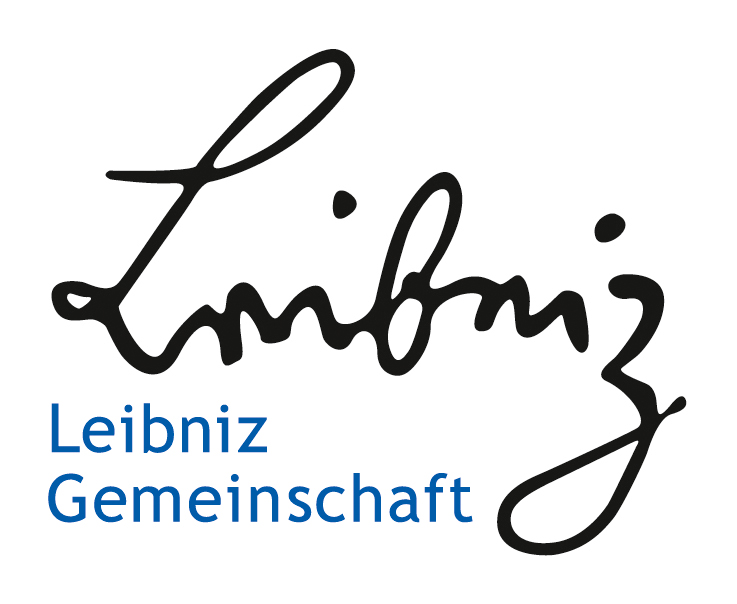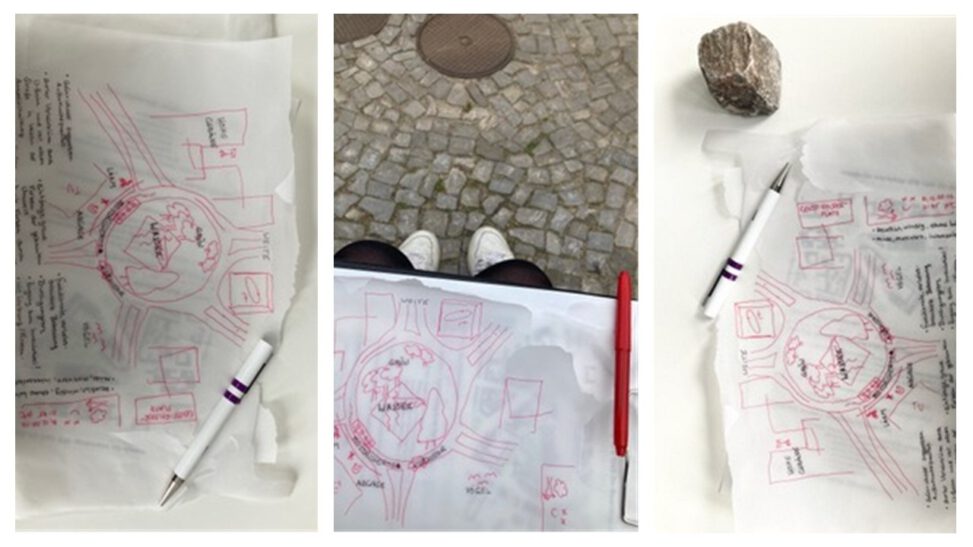Using your senses to map the world
Author:
Sophie Krone
Citation:
Krone, S. (2024): Sensory Mapping. Using your senses to map the world. In: VisQual Methodbox, URL: https://visqual.leibniz-ifl-projekte.de/methodbox/2024/01/31/sensory-mapping/
Essentials
- Importance: Emotions and sensory experiences are an essential part of social life, so researching them is therefore crucial.
- Aims: Sensory maps aim to explore and visualize perceptions, feelings and atmospheres and thus provide access to emotional spatial knowledge.
- Trust: Trust between participants and researchers is very essential as emotions can be a sensitive topic that can be challenging to research.
Description
Sensory mapping, as an umbrella term, refers to a branch of visual research methods. They focus on the relationship between subjects (individuals or groups) and their spatial references, in other words, they show the relationships between perception, emotional experience and practices and situate these in a spatial context (Bittner/Michel 2018: 298; Schmidt-Lauber/Zechner 2018: 14). Based on the idea that subjects experience their spatial environment with their senses, the aim is to explore and visualize these subjective experiences by means of mappings. The resulting visualization is based on their personal emotions and feelings. Powell (2010) points out that mappings, through their ability to appeal to the senses, „highlight the involuted relationships between self and place and the ways in which self and place are mutually constitutive and relational“ (553).
Researching spatiality through the lens of subjective senses and emotions may provide an important insight e.g. into the connection of subjects to certain places, based on biographical and historical connections (Berrens 2016: 80). This connection between emotions and places is considered to highlight the situatedness of subjects with respect to their bodily presence in the world (Haraway 1988; Pink 2009).
Sensory mapping can be understood as part of critical and, depending on the method, participatory mapping, as these are power-sensitive methods. That means they consider the power relations inscribed in the research context as well as in the methods themselves, and engage critically with them, reflect on them and, where possible, attempt to counteract them (Dammann/Michel 2022; Kim 2015). It is important to deal with these power relations also in sensory mapping because, as Ahmed (2004) emphasizes, they are also expressed through emotions. In the context of the “sensory turn”, there has been a shift in research towards the importance of the senses and sensory experience (Pink 2013: 261). This also led to a change in the boundaries between scientific research and artistic work, which enabled the development of new research methods (Dickel et al. 2018: 50). Pettig (2022) draws attention to the potential of artistic cartographies to use “creative and multimedia formats of visualization” and the possibilities of mapping as an “ongoing process of explorative engagement with places, of experimental and intentional documentation and the search for ways of displaying what is perceived, sensed and experienced on site” (169).
The methods of sensory mapping vary depending on the specific method (see e.g. Emotional Mapping), yet often involve working with groups or individuals that engage in the process of mapping. This engagement can be accompanied by interviews to generate and elaborate on narratives in and about the respective mappings, ultimately producing at least two sets of data: the participants’ own visualizations and documentation of the researchers’ conversations with them. From an analytical point of view, these have subsequently to be integrated in the process of interpretation (Behnken/Zinnecker 2010; Klaus et al. 2022; Million 2021). Whilst the combination of visualization and verbal communication allows the participants different modes of expression for their emotions, sensory mapping sometimes requires the researcher to provide practical introductions, support, or guidance for the participants, because talking about emotions can be challenging, as the translation of feelings into language or drawings is necessary for intersubjective comprehensibility. As sensory mapping usually involves rather such personal accounts, the single most important premise for a fruitful mapping process is mutual trust between all participants in order to prevent feelings of shame, discomfort, and social unacceptability (Manek/Fernández de la Reguera Ahedo 2022: 58).
Procedure
The detailed steps of the mapping process depend on the respective method. Below, some basic steps will be explained.
- Step 1: What?
First and foremost is the question of what is to be found out with the respective method. Is the selected method suitable for answering your own research question? Which methods have which advantages and disadvantages? For example: Emotional mapping deals with the localization of emotions by using different color codes and mental maps (Klaus et al. 2022), while relief maps focus on the intersectional differentiation of emotions, which is visualized through a type of diagram (Schmidt et al 2022). - Step 2: Who?
The second step of the mapping process is to identify who is creating the maps together with whom. Whose emotions and sensory experiences are interesting for answering the respective research question(s)? How does the positionality of the researchers relate to that of the participants? The question of positionality implies a reflection on how one’s own biography and socio-cultural characteristics influence research (Katz 1994; Marguin et al. 2021). - Step 3: How?
The next step is to realize the planned methodological approach. This includes questions such as: How do I gain access to the field? What materials do I need? During the actual process of mapping, it is important to document the procedure well so that decisions and developments can be reconstructed later. The methods vary in terms of the resources in need. This relates both to the material requirements and to the time commitment of the researchers and participants. Is the mapping accompanied by an interview? Is a workshop conducted with several people over the course of multiple hours? In any case, a place is needed where the meeting can take place undisturbed and the participants feel comfortable. - Step 4: What’s next?
After the data has been collected, the question arises as to how the data can be analyzed, documented and presented. This depends heavily on the method used and can involve analyzing the data using methods such as grounded theory as well as integrating it with other research data in the process of triangulation. It might also be possible to digitalize the resulting maps using programs such as ArcGIS.
Requirements
- Participants who are willing to share personal emotions and have the cognitive and reflective capacity to verbalize or draw them. This cannot be stated objectively, but in the course of the research process it becomes noticeable in what extent people are able to communicate their emotions.
- Motivation and sensibility in the participants.
- Individuals who are actively perceiving spaces and places with their senses
- Data exploration can be done with few materials
Evaluation
- Contexts: Data Exploration, Publications
- Efforts: Depending on the actual method 1-4 weeks: e.g. field access, preparation of accompanying interviews or workshops, execution of the method as well as subsequent evaluation and possible follow-up tasks
- Sensible data can require specific form of data protection and storage
- Costs: low costs for workshop materials, none for digitalization tools if open source programs or university licenses can be used
Useful Ressources
- https://www.qualitative-methoden.giub.unibe.ch/sense-maps/
- Jager, A. de, Tewson, A., Ludlow, B. and Katherine M. Boydell (2016): Embodied Ways of Storying the Self. A Systematic Review of Body-Mapping. Forum Qualitative Social Research 17, Art. 22.
- Kollektiv Orangotango (2018): This is not an atlas: A global collection of counter-cartographies. Bielfeld: transcript.
- McLean, K. (2012): Emotion, Location and the Senses: A Virtual Dérive Smell Map of Paris. London: Out of Control Conference.
- Powell, K. (2010): Making sense of place: mapping as a multi-sensory research method. Qualitative Inquiry 16, 539–555, https://doi.org/10.1177/1077800410372600
- Rodó-de-Zárate, M. (2014): Developing Geographies of Intersectionality with Relief Maps. Reflections from Youth Research in Manresa, Catalonia. Gender, Place & Culture 21, 925–944, https://doi.org/10.1080/0966369X.2013.817974
Suggested Tools
- Software: e.g. ArcGIS,QGIS. Inkscape
- Data sources: interviews, participative workshops
- Tools: paper, (coloured) pencils, photo cameras, stickers, post it’s
References
Ahmed, S. (2004): Affective economies. Social Text 22(2), 117-139, https://www.muse.jhu.edu/article/55780
Behnken, I and Zinnecker, J. (2010): Narrative Landkarten. Ein Verfahren zur Rekonstruktion aktueller und biografisch erinnerter Lebensräume. Enzyklopädie Erziehungswissenschaft online. Weinheim: Beltz Juventa, https://doi.org/10.3262/EEO07100128
Berrens, K. (2016): An emotional cartography of resonance, Emotion, Space and Society, 20, 75-81, https://doi.org/10.1016/j.emospa.2016.06.005
Bittner, C. and Michel, B. (2018): Partizipatives Kartieren als Praxis einer kritischen Kartographie. In Sozialraum erforschen. Qualitative Methoden in der Geographie, Hrsg. Wintzer, J., Berlin: Springer VS, 297–312.
Dickel, M; Keßler, L. (2019): Zwischen sinnlichem Erleben und sprachlich-rationalem Begreifen: zur Reflexion der ästhetischen Dimension der Forschung in der Geographie, Europa Regional, 26(1), 49-61, https://nbn- resolving.org/urn:nbn:de:0168-ssoar-63918-6.
Haraway, D. (1988): Situated knowledge: the science question in feminism and the privilege of partial perspective. Fem. Stud. 14 (3), 575-599, https://doi.org/10.2307/3178066
Katz, C. (1994): Playing the Field: Questions of Fieldwork in Geography. The Professional Geographer 46(1): 67–72, https://doi.org/10.1111/j.0033-0124.1994.00067.x
Kim, A. M. (2015): Critical cartography 2.0: From “participatory mapping” to authored visualizations of power and people. Landscape and Urban Planning 142, 215–225, https://doi.org/10.1016/j.landurbplan.2015.07.012
Klaus, L.; Germes and M.; Guarascio, F. (2022): Emotional Mapping und partizipatives Kartieren – ungehörte Stimmen sichtbar machen. In Handbuch kritisches Kartieren, Hrsg. Dammann, F. and Michel, B., Bielefeld: transcript, 37–53.
Manek, J. and Fernández de la Reguera Ahedo, A. (2022); Psycho-geographisches Countermapping – Einsicht in Migrationshaft und andere opake Institutionen. In Handbuch kritisches Kartieren, Hrsg. Dammann, F. and Michel, B., Bielefeld: transcript, 55–69.
Marguin, S.; Haus, J.; Heinrich, A. J.; Kahl, A.; Schendzielorz, C. and Singh, A. (2021): Positionality Reloaded. Debating the Dimension of Reflexivity in the Relationship Between Science and Society. An Editorial. Historical Social Research 46(2): 7–34. https://doi.org/10.12759/hsr.46.2021.2.7-34
Million, A. (2021): Mental Maps und narrative Landkarten. In Methoden der qualitativen Raumforschung. Ein interdisziplinäres Handbuch, Hrsg. Heinrich, A. J.; Marguin, S.; Million, A. and Stollmann, J., Bielefeld: transcript, 293–308.
Pettig, F. (2022): Ästhetisches Kartieren – Mapping als Praxis geographischer Forschung zur räumlichen Erfahrung. In Handbuch kritisches Kartieren, Hrsg. Dammann, F. and Michel, B., Bielefeld: transcript, 169-180.
Pink, S. (2009): Doing sensory ethnography. London: SAGE.
Pink, S. (2013): Engaging the Senses in Ethnographic Practice. Implications and Advances. The Senses and Society 8: 261–267, https://doi.org/10.2752/174589313X13712175020433
Powell, K. (2010): Making sense of place: mapping as a multi-sensory research method. Qualitative Inquiry 16, 539–555, https://doi.org/10.1177/1077800410372600
Schmidt, K.; Singer, K.; and Neuburger, M. (2022): Comics and Relief Maps als feministische Kartographie der Positionalität. In: Handbuch kritisches Kartieren, Hrsg. Dammann, F. and Michel, B., Bielefeld: transcript, 181–202.
Schmidt-Lauber, B. and Zechner, I. (2018): Mapping: Begriff und Verfahren. Zeitschrift für Kulturwissenschaft Mapping 12(1), 11–17, https://doi.org/10.25969/mediarep/13876



Leave a Reply